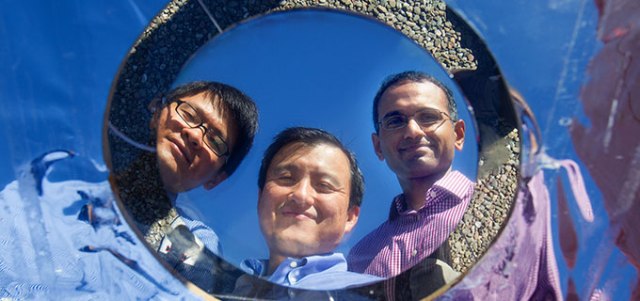Stanford engineers have created a thin, transparent, patterned silica overlay capable of raising efficiency levels of solar cells by cooling them even when they are exposed to full sunlight.
 Doctoral student Linxiao Zhu, electrical engineering professor Shanhui Fan and research associate Aaswath P. Raman are Stanford engineers who have developed a thermal overlay to cool solar cells. Credit - Stanford Engineering.
Doctoral student Linxiao Zhu, electrical engineering professor Shanhui Fan and research associate Aaswath P. Raman are Stanford engineers who have developed a thermal overlay to cool solar cells. Credit - Stanford Engineering.
When solar cells get very hot, they tend to lose their conversion efficiency. This issue has been a challenge for solar panel manufacturers for many years. By radiating heat into space, the transparent overlay optimizes the solar cell efficiency.
When a person steps out into the sunlight, he/she radiates energy as infrared light into space from the top of the head. The Stanford researchers borrowed this basic idea to develop this technology. The newly created silica overlay is placed over a conventional solar cell. It is designed to force the heat produced by the solar cells away and cool it so more photons are converted into electricity.
The overlay is transparent to the visible sunlight, which is the energy source for the solar cells, but traps and discharges heat from infrared rays.
The researchers include Shanhui Fan, a professor of electrical engineering at Stanford, research associate Aaswath P. Raman and doctoral candidate Linxiao Zhu.
Solar arrays must face the sun to function, even though that heat is detrimental to efficiency. Our thermal overlay allows sunlight to pass through, preserving or even enhancing sunlight absorption, but it also cools the cell by radiating the heat out and improving the cell efficiency.
Shanhui Fan, a professor of electrical engineering at Stanford
A Cool Way to Improve Solar Efficiency
The same team was involved in the creation of an ultrathin material in 2014. This material radiates infrared heat directly into space without increasing the temperature of the surrounding air. This work was published in the journal Nature, where the concept was described as “radiative cooling" as heat was radiated directly to space.
In the current research, the Stanford team applied the material to enhance the performance of solar panels especially during peak sunlight. They tested this material on a tailor-made solar absorber, which imitates a solar cell’s properties but does not produce electricity. They covered the solar absorber with a micron-scale pattern capable of shunting heat as infrared light into the atmosphere. The experiment revealed that the transparent material allowed visible light to reach the solar cells, but maintained the underlying absorber at a temperature of 23°F.
In a standard crystalline silicon solar cell possessing 20% efficiency, 23°F of cooling would translate to over 1% absolute cell efficiency, which is a considerable increase in energy production.
The Standford researchers recommended that the transparent overlays would ideally be suited for clear and dry environments, which happen to be ideal for large solar panels. Going forward, they hope to extend their invention for use in several commercial and industrial applications using nanoprint lithography, which is widely used for creating nano-scale patterns.
That's not necessarily the only way. New techniques and machines for manufacturing these kinds of patterns will continue to advance. I'm optimistic.
Raman, a co-first-author of the paper
Cooler Cars
Zhu stated that the invention could also be adapted for many outdoor devices or systems, which not only require cooling but also need the visible light to be preserved for aesthetic or practical purposes.
Say you have a car that is bright red. You really like that color, but you'd also like to take advantage of anything that could aid in cooling your vehicle during hot days. Thermal overlays can help with passive cooling, but it's a problem if they're not fully transparent.
Zhu
For color perception to happen, objects would have to reflect visible light. Therefore, any overlay would have to be transparent, or to be tuned to absorb only light beyond the visible spectrum.
"Our photonic crystal thermal overlay optimizes use of the thermal portions of the electromagnetic spectrum without affecting visible light," Zhu said, "so you can radiate heat efficiently without affecting color."
The study findings have appeared in the journal, Proceedings of the National Academy of Sciences.
References